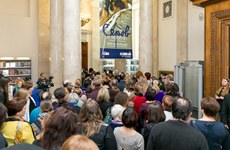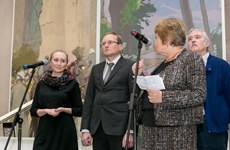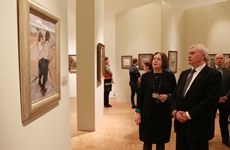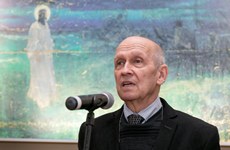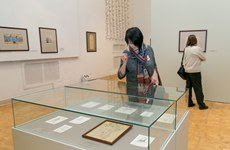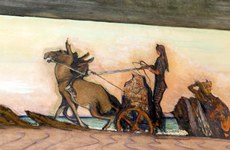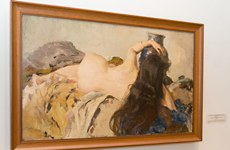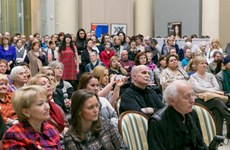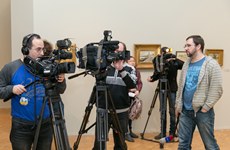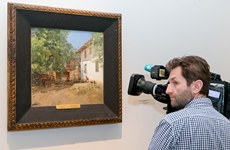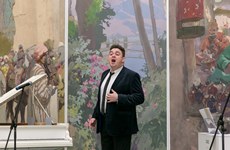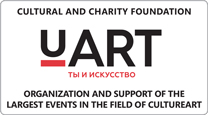Anniversary exhibition of Valentin Serov
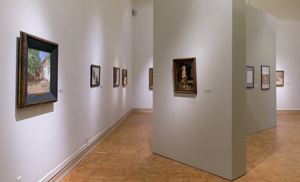 An exhibition dedicated to the 150th anniversary of
the birth of Valentin Serov opened in the Russian Museum in Saint Petersburg.
More than two hundred and fifty paintings, graphics and sculptures selected for
the exhibit named “Serov, other than a portrait painter”, make the audience
take a fresh look at the artist’s creative development. The exhibition is
hosted under the auspices of UNIDENT group of companies
An exhibition dedicated to the 150th anniversary of
the birth of Valentin Serov opened in the Russian Museum in Saint Petersburg.
More than two hundred and fifty paintings, graphics and sculptures selected for
the exhibit named “Serov, other than a portrait painter”, make the audience
take a fresh look at the artist’s creative development. The exhibition is
hosted under the auspices of UNIDENT group of companies
The work on the exhibit has been being conducted for a year
and a half. It united the collections of the Russian Museum, the Tretyakov
Gallery and private collections. An unusual concept of the exhibit surprises
the audience: Serov is famous for his portraits, but his creative work goes far
beyond the scope of this genre. Here, the maestro is presented as a history
painter, genre painter, landscapist and author of works which antedated the
discoveries of Russian
The exhibit takes place in the Benois Wing and will be opened until the eighth of June.
Evgenia Petrova
Deputy Director for Research of the State Russian Museum
 — We
were worried about this exhibition, because we understood that all people think
that Serov is a portrait painter. We needed to represent the artist in a
different way. It seems to me that neither the public nor our dear lovers of
art do really know this artist. But his work includes all characteristics of
the Impressionism and almost
— We
were worried about this exhibition, because we understood that all people think
that Serov is a portrait painter. We needed to represent the artist in a
different way. It seems to me that neither the public nor our dear lovers of
art do really know this artist. But his work includes all characteristics of
the Impressionism and almost
Therefore, it would be desirable that every visitor understand this. Each piece of art represents creative life of the artist. Any of his small study, if you start to look into it, and even look at the date, can be very surprising. And we wanted arrange the exhibition so that the audience would not pass the works by: «Oh, I have already seen it. This lighting is better.” We wished people look at them attentively. We tried to get avoid the endless repetition of the same visual range, and make the viewer think.
Vladimir Kruglov
Senior research scientist of the Department for painting of the second half of the 19th century – beginning of the 21st century in the State Russian Museum
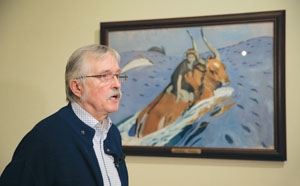 I am, as a historian of art, is interested in that at
this exhibition a number of items from various museums was collected in the
same place. And there was that same picture, which once was observed at
exhibitions or in general fixed in the Russian artistic life in the years of
Serov.
I am, as a historian of art, is interested in that at
this exhibition a number of items from various museums was collected in the
same place. And there was that same picture, which once was observed at
exhibitions or in general fixed in the Russian artistic life in the years of
Serov.
In seven halls we exhibit more than 200 works — paintings, drawings, a large number of images that can be seen for the first time, and those from our collections and from the collection of the Tretyakov Gallery, etchings and even one sculpture. It is exhibited in the last room — a work associated with the ancient myth of the rape of Europe.
Not only the Tretyakov Gallery gave us its works, but also
Brodsky’s
We have not discovered any rare items that have not been already known to science while preparing the exhibition. There is just a few of works by Serov in private collection, and they are all known to us. Although, for example, in the hall, where we exhibit nudity, a Resting Faun is displayed. We did not know this picture. We suddenly discovered it six months ago, and found out that this work deserves being on display. Although, we then realized that it was exhibited several times in the 1950s at Serov’s anniversary exhibition.
But for the audience, the exhibition is in any case a discovery. We tried to make it this way — Serov without portraits. We wanted to show that landscapes, and history paintings, and his nudes, and images of animals and animals in general, his caricatures, his theatrical works — everything is fine. Works are characterised by high artistic qualities, like portraits that everyone knows and that someone may not love, but, in any case, values.
Vladimir Leniashin
Head of the Department for painting of the second half of the 19th century – beginning of the 21st century in the State Russian Museum
 – This exhibition is the first experience in such kind
of setting objectives, and it is rare that something happens for the first
time. Charm of Serov’s paintings different from portraits is seen by our
contemporaries, and earlier researchers — all these were separate estimates. Of
course, we are well aware of that Serov entered the world of culture as a
portraitist. But all his works are perfect. I do not exaggerate saying all!
– This exhibition is the first experience in such kind
of setting objectives, and it is rare that something happens for the first
time. Charm of Serov’s paintings different from portraits is seen by our
contemporaries, and earlier researchers — all these were separate estimates. Of
course, we are well aware of that Serov entered the world of culture as a
portraitist. But all his works are perfect. I do not exaggerate saying all!
I will not reveal a big secret if I say that we prepare exhibitions in the atmosphere of disputes. This is our style, and we are proud of it. But from the outset this exhibition has caused an unusually high number of disputes, in which everyone involved took part.
We hope that our huge efforts taken for this exhibition and, most importantly, the works themselves will tune in the viewer to another wave and reveal something new about the artist.
Vladimir Kruglov:
— Unfortunately, we were not able to restore the „Christ Walking on the Water“ work. The fact is that it was poorly stored. This is a huge mural — about 6 to 7 meters, which was painted by Serov together with Konstantin Korovin for the parish church in Kostroma factory. During the struggle with the church, it was removed and rolled up. The work now demonstrates vertical stripes with lost painting — the roll was obviously pressed by something.
There are many difficulties in restoring the painting, because dust and smoke settled on the surface for many years, and in church painting was covered with varnish or lacquer. It is poorly soluble composition, seems to be an alloy. So, our restorers have not yet restored the canvas. It requires long and painstaking work.
But, nevertheless, as we rolled out this work, we decided to show it to you, at least, in the form of a reproduction. This is not just our treasure, but a new look at the work of remarkable artists Valentin Serov and Konstantin Korovin. It is difficult to imagine that Korovin created paintings on such religious themes. And yet, here he created a picture of a storm on the Sea of Gennesaret, while the figures of the Savior and his disciples in the boat, which are barely distinguishable, are depicted by Serov.
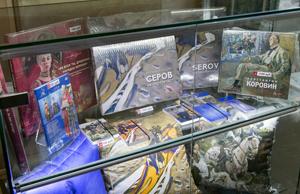 — Not less interesting is a restored picture Odyssey
and Nausicaa. We're still getting in it. The period of restoration was not
long, the painting was in good condition. It was necessary to correct a frame.
And when restorers rolled it out they found out fields at the top and bottom.
And we decided that it is interesting and worthy of attention, because the
picture with fields is perceived differently. Who rolled it in is not clear,
but the stripes that we now see, give a sense of dynamics. They speed the
movement of the Nausicaa’s chariot and Odyssey shyly following her along the
seashore. The artist depicted what he intended to.
— Not less interesting is a restored picture Odyssey
and Nausicaa. We're still getting in it. The period of restoration was not
long, the painting was in good condition. It was necessary to correct a frame.
And when restorers rolled it out they found out fields at the top and bottom.
And we decided that it is interesting and worthy of attention, because the
picture with fields is perceived differently. Who rolled it in is not clear,
but the stripes that we now see, give a sense of dynamics. They speed the
movement of the Nausicaa’s chariot and Odyssey shyly following her along the
seashore. The artist depicted what he intended to.
By the exhibition date an almanac with the same title representing a more complete collection of works by the artist than actually exhibited was published. It also reproduces paintings from private collections and small museums that were not exhibited. But they are demonstrated in the catalog, and help to create a sense of the artist’s searches and the grandeur of Valentin Serov’s figure.
Back

